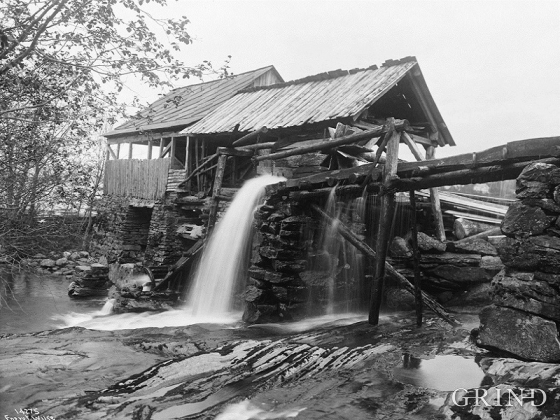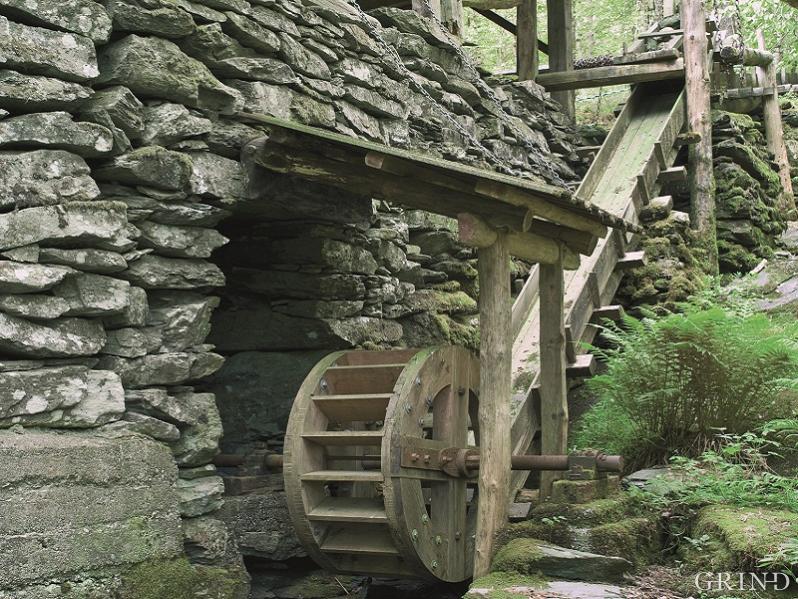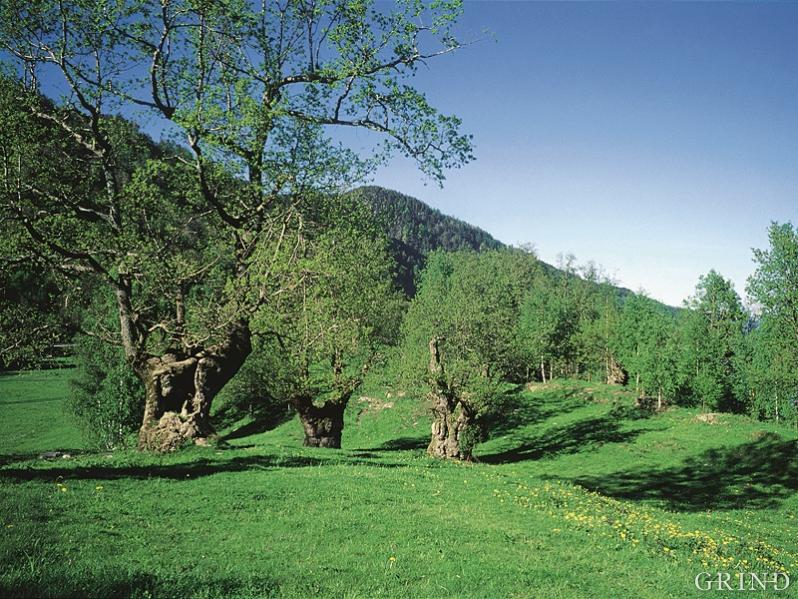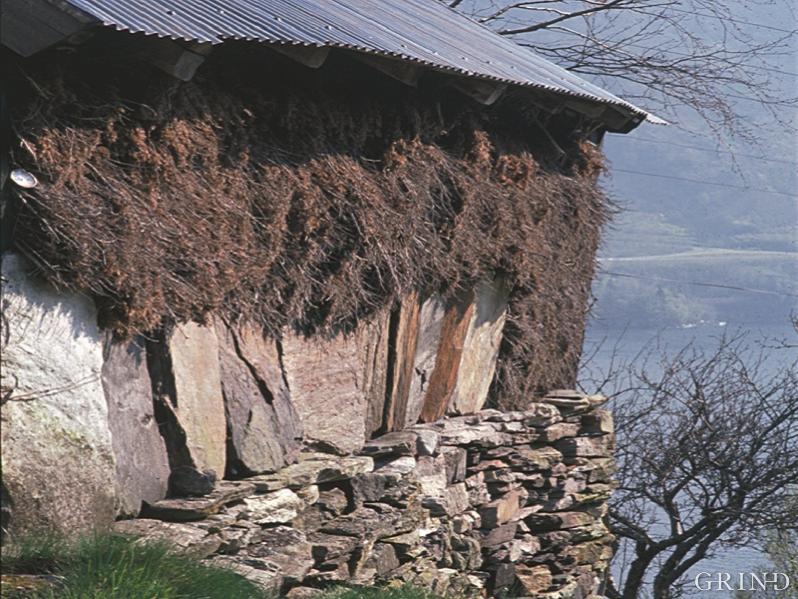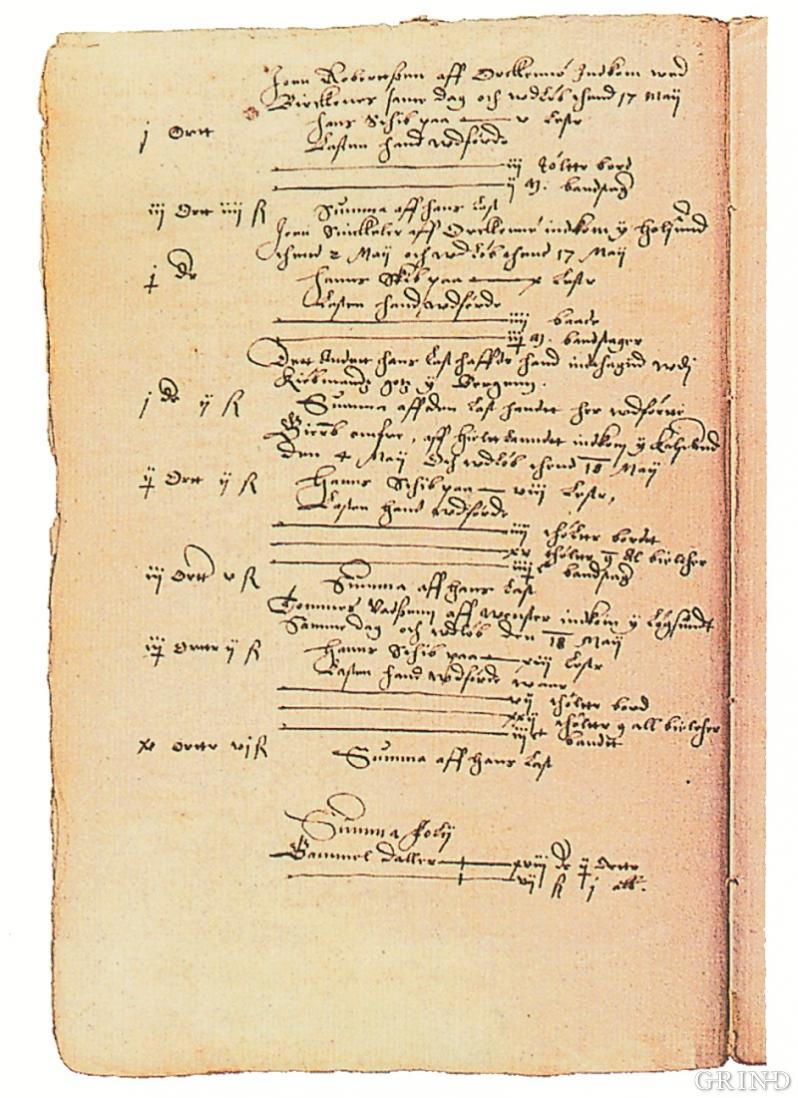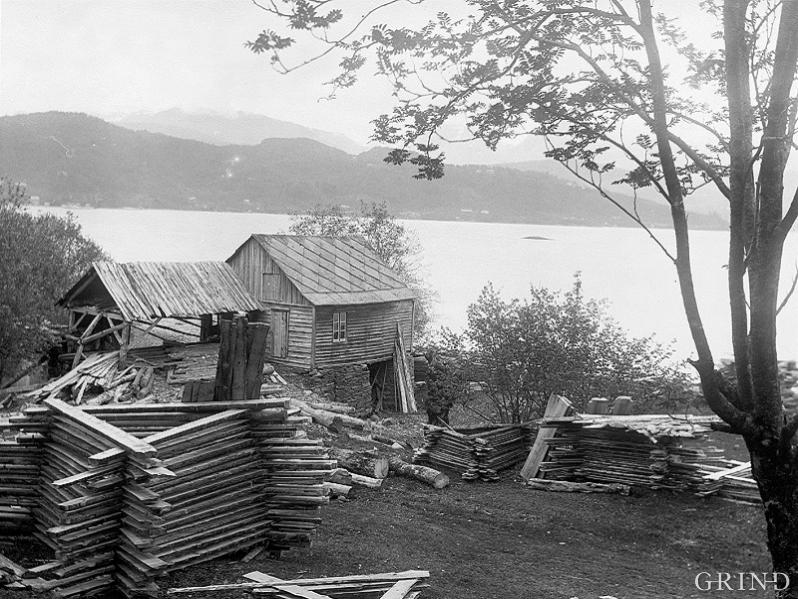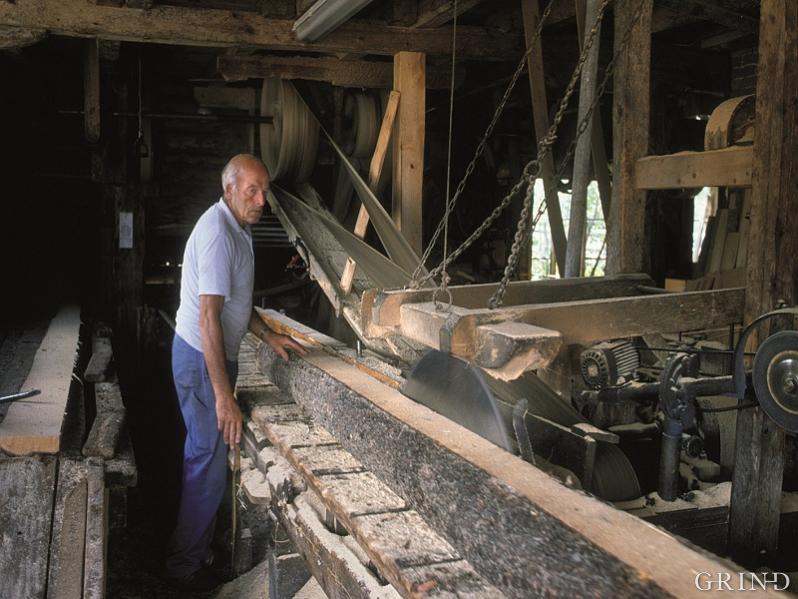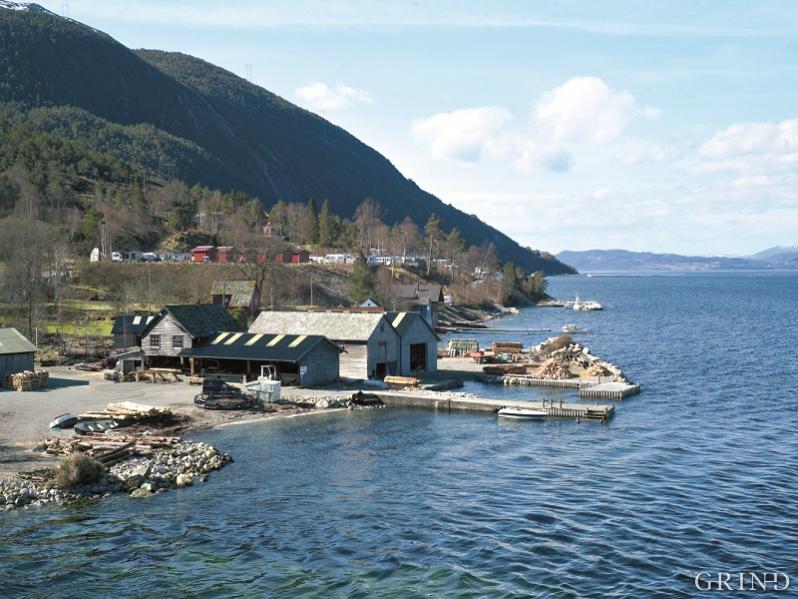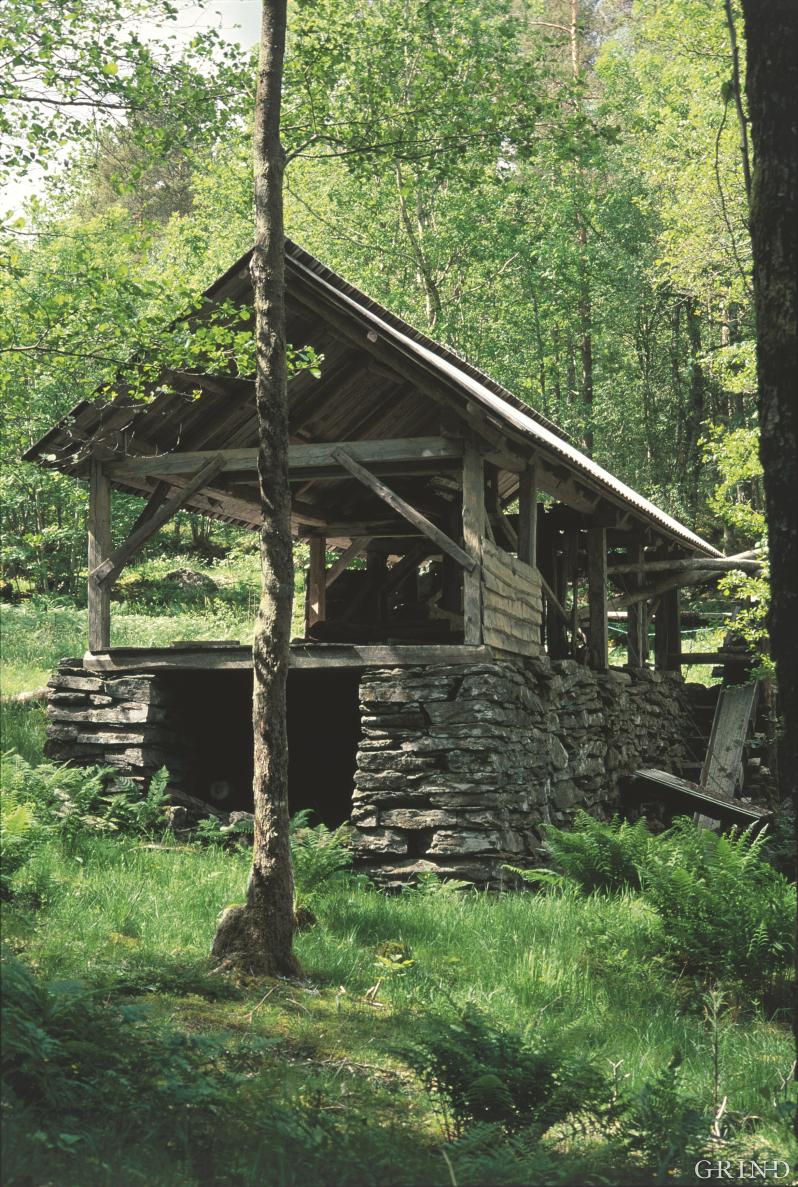Published: 19.05.2009 | Author: Danckert Monrad-Krohn
The Byrkjeland saw on Vikøy in Kvam in 1912 (A. B. Wilse, owner: Norwegian Folkmuseum (14275)).
“THE GOLDEN AGE OF THE 17TH CENTURY”
“Rats and Scots are of no use to man nor beast” was a popular saying in Bergen. It reflects the annoyance expressed by town businessmen when the extensive “Scots trade” flourished after a Customs house was established at Eldøyvågen on Stord in 1590. Then the Scots and others could avoid sailing through Bergen when they were fetching timber from Sunnhordland and Hardanger. The timber trade with the Scots and the Dutch has been described as the “Golden Age of the 17th Century” in the west of Norway. The sash saws, the technological innovation of the 16th century, stood at every river mouth in the fjord settlements where there was timber to be gotten, and where it was easy to ship it out. The water saws cut beams and tables out for boatbuilding and housebuilding, for domestic use and for export across the North Sea. The Scots ships sailed into the Hardangerfjord, to Strandebarm, Jondal and right up to Ulvik to load rough timber and sawn timber. This klondyke period lasted until the middle of the 18th century and led to overcutting of the forest in the fjord areas. Here there had grown from ancient times a vast and straight-growing pine forest.
The forest
As long as people have lived in this country the forest has grown here, also in areas which are free of trees today. Finds in the bogs have shown that Hardangervidda and the outer coast areas were forest-clad in prehistoric times. Perhaps we do not know so much about the day-to-day life of Stone Age man, but we do know that he used the forest as his hunting grounds. We know that he used wooden trunks as posts and branches as walls for his house, that he had handles on his utensils, that he could travel on rivers and lakes in carved out tree trunks, that he used firewood to warm himself and to cook food. It is not surprising that Norse mythology’s symbol for the totality of existence was a tree: the Yggdrasil ash.
Later on in historic times, when our sources become richer we get a good impression of how extensive and varied our use of forest and the tree has been. Today other materials have taken over in a series of areas where the tree has previously been in universal use. The experience of generations on what type of wood was best suited for different purposes is about to be lost. Not only did the forest provide materials for the house, for transport, for vehicles, utensils and furniture. It gave firewood and incomes; it provided food for man and beast, it gave medicines and witchcraft materials and brought important signs of the year’s growth.
Pine and oak - the building materials
Pine is one of the most important species of tree. It forms a hard heartwood. This dense, resin-soaked heartwood is resistant to damp, rot and insects and so is well suited for boat planking and building materials. Carpenters in former times were especially careful to make sure that particularly exposed building materials were made of heartwood.
The development of heartwood is a slow process which could take many generations. But our forefathers knew what they were about. By taking off the bark of the pine, as it grew and by cutting the tree at the top they intervene in the natural growth process and hastened the formation of the resin so that after some years they got good heartwood. But it did take time, and we get a clear picture of how all work had to be prepared and planned in good time. Where the tree grew was also significant for the quality of the wood. For example, according to tradition, clay-slate soils did not give such a hard quality as gneiss-granite soils. At Berge in Tørvikbygd they were careful to make sure that a rake shaft came from a granite soil. The rest of the rake could be made from ash.
Pine was also used for barrel staves and for all types of staved vessels, wooden clogs and bailers, oars and masts, boxes and other utensils. From Ulvik and Voss we know that children ate the young shoots in the spring, and in Strandebarm the pine sprigs were used as fodder for sheep and goats in winter.
At Stekka on the Berge farm, which is today a protected area of landscape beauty, we also find another important species of wood for boat-building, that is oak. How old the gnarled oak planks actually are we do not know for certain, but they are certainly several hundred years old. Their shape tells of generations of use and care. Because also here our forefathers did not leave everything to Nature. This oak was used primarily for boat materials. Not for decking like pine, but for the interior, for the prow, the keel, the stern and ribs. This was for parts that need a natural curvature in them so as to be strong enough. To obtain this sort of material, the oak was trimmed and the curved branches which grew up from the oak stump were cut when they were needed. Again we encounter the need for long-term planning.
But oakwood was used for more than building boats. It was suitable for most purposes where there was a need for a hard wood. In addition the bark was used for tanning of hides and impregnation of nets and fishing line. Acorns could be used for pig food, and in times of need, as a substitute for coffee. It was well known that the oak could serve as a sign of summer. “If the oak before the ash, then we will get a splash. If the ash before the oak then we are in for a soak”.
Hazel and willow - a source of wealth on the farm
Another important tree was the hazel, or the hatl as it is known in dialect. The long, straight-growing trunks and branches free of knots were long used as wood for bands round barrels, tubs and the great number of staved vessel used around the farms. There was a great need for these bands, and on farms which had hazel woods, forging of bands, hazel bands, provided a very welcome income during the winter. In many places we still find the stool and the band knives which were used to forge the bands. The hazel had to be looked after if it was to give good quality bands. It was frequently cut down to the roots. Good hazelwoods were of great value and many places were taken into account on the change of ownership of the farm.
Hazel nuts were picked for domestic consumption and for sale and for barter. We can appreciate from the Frostatingsloven that (nutwoods) were regarded as a source of wealth. There it says that no man shall enter another man’s nutwoods, but if he does then he must give up the nuts and pay a fine to the owner. The hazel was regarded as a holy tree in Norse mythology.
A tree which we quickly notice because of the beautiful deep green colour of its needles is the yew. Today it is a rare tree. At least it is rare to be able to find such big example as one finds in Torvikbygd. The yew grows slowly and gives a firm, tough and lasting timber. It is therefore highly prized as material. In the older Edda the yew is described as a material for bows, and yew bows were exported to England in the Middle Ages. It was also yew bows which were used in hunting minke whale in Skogsvågen on Sotra. This form of hunting continue right up to about 1900. Today we find one of the bows from there in Hordaland Museum. A more common use of yew was for nails. It is yew nails which hold the slate slabs in place on the boathouses in Stekka. But despite its beauty the yew is poisonous!
The juniper - tough and lasting
If the yew is uncommon then one can say the opposite of the juniper, or “braken” In large parts of Hordaland it grows like a weed and puts its imprint upon the cultural landscape. In some places we can still see whole groups of juniper with straight growing trunks. There is scarcely any other tree which has such a wide range of uses, either in a working environment or in legend.
The core wood is firm, tough and lasting because of its high resin content. Where it grew with straight trunks it was preferred for hay-drying and fence poles.
For all vessels which were to be used for food, milk churns, butter dishes, churns, salt stamping mills for fish and meat, beer barrels juniper was regarded as the best. Food stayed fresh in such vessels and took on a nice smell. Belief in the juniper’s antiseptic effect also emerges in the use of juniper extract, a concoction of juniper and water. It was regarded as excellent for the cleaning of all types of wooden vessel. It smelt good and many people thought that it helped with hair loss. But juniper extract was also good fodder, and in Modalen it was especially used for cows which had just calved. The juniper bush itself was much used as fodder for sheep and goats. It was regarded as good fodder and not mere emergency feed.
A multiple resource
In olden times when a farmer travelled around in the forest it was always with an eye to what each individual tree could be used for. He noted where a birch stood which could be suitable as sledge runners which would have to be exchanged in some years time. He noticed that some hazel thicket would soon have to be cut and that the oak would have to be trimmed. Each tree was assessed carefully for working it or for felling. In our time the forest represents a much less complex resource which, first and foremost shall give a direct financial profit to the owner. Selective felling of earlier times has now been replaced by area felling.
In earlier times the forest could also be so heavily exploited that it completely changed character or disappeared, for example by mountain pasture farming in the birch belt or by salt boiling which needed great quantities of fuelwood. Salt is an important preserving agent which was produced by boiling seawater. In the coastal villages of Hordaland this activity was extensive and Hardanger salt was a well known token. We find remembrances of this activity in the place names like Salthella in Austevoll, Salbuvik in Os and Saltbu in Fana. On the Haukanæs farm in Granvin along the beaches we can still see the sites of the salt huts and the salt ovens. But the activity which had the greatest significance for the exploitation of the forest was nonetheless the sawmill.
The sash saw
Water-powered sash saws were already in use further south in Europe in the early Middle Ages. In 1447 we hear of a such a saw at the Vadstena Monastery in Sweden, and in 1503 two saws are referred to at Mossefossen in Østfold County. If these really were the first sash saws in Norway remains to be seen In any event it is certain that there was a rapid extension of sash saws in Norway during the 16th century.
The basis for receiving this technological innovation was present. Water-powered grinding stones and mills had been in use here in this country for several hundred years so that knowledge of water as a source of power was already known and there was no shortage of rivers and streams. Earlier descriptions indicate that the sash saw was in principle fully developed by the time it reached Norway. It was based on simple technical principles and the different parts of the saw could be produced in the local society.
Before the time of the sash saw – in the Viking times and in the Middle Ages - one got oneself a table by clear felling splitwood halves. The slender strakes in the Viking ships and the wall tiles in the stave churches are made in this way. The log was split lengthwise along the middle with a wedge axe and the two halves planed level with a broadaxe. Thus each log provided only two tables. This meant that over half the log could disappear in the form of waste. It is in the light of this background that should view the epoch-making saving of raw material which the sash saw brought with it.
Even although much indicates that the new type of saw had come to Hordaland several decades earlier, the first certain sources are from 1563. At that time we can see that 11 saws have been in operation in Sunnhordland. That we first come across the water-powered saw in Sunnhordland is much in accordance with what we know about local conditions. While the old Norwegian noble and large farming families elsewhere were impoverished and had ended up as tenants, the old families in Sunnhordland and Hardanger were thriving. We can see from the tax lists that it was precisely this group who took up using the water-powered saws earliest. They had an excellent supply of timber, and they were well used to overseas trade.
From the Viking times these villages had been in contact with the countries around the North Sea. During the 16th century trade increased and in 1590 it had reached such an extent that a customs house for Sunnhordland and Hardanger was established at Eldøyågen on Stord. Here all ships had to make Customs declarations, for both incoming and outgoing cargoes. From the Customs accounts we get a good view of the extent and character of the trade. We see that it is first and foremost vessels from north-east Scotland, from towns like Leith, Dundee, Montrose and Aberdeen who have visited the region, but we also find vessels from the Orkney Island, Hjaltland (the Shetlands) and from more southerly locations like Rotterdam and Hindeloopen in Holland. Even although the Scots did not reign supreme in this trade, it was called in common parlance, “the Scots trade” and the period was called the “Scots period”.
The scots trade
The first vessels arrived early in the Spring and the last one left in the late Autumn. Several of the vessels lay waiting for weeks to assemble enough cargo. The cargo consisted of timber, sawn timber, sawn planks, beams, but also fuelwood, wooden material for vessels, hoops and whole boats.
In payment for the wood and timber they brought consumer goods like corn, flour and malt, rough textile materials, shoes, stoneware and glass, tools, copper and iron pots, and also articles like beer, wines, spirits, tobacco, silk and sweets as well as hard cash.
The Scottish skippers went round and traded a little here and a little there. In this way the Scots trade had significance for most of the farms in the area. The rich traditional material from the Scottish period tells of dependence and friendship. A song from Hatlestrand in Kvinnherad has it: “If the Scots do not come this year then we won’t be able to sell our logs”. Hatlestrand went by the name of the Scottish village because of the many Scots seamen who had got married there. And the many place names which reflect the Scots trade, say their bit. At Sundvorøy in Fusa a stone was called a Scots anchoring place. It was here that the Scots had tied up their ships. Right beside are great heaps of ballast stone in the sea - from the Scots, according to tradition. We find the same thing in Jondal and in Ulvik. On an underwater rocks (visible at low-tide) the ships were keel-hauled. In the first period in the 16th century the sawmill business, as we have seen, was dominated by noblemen and by large farmers, but this did not last for long. In the next two centuries we find a social and geographical extension of the business. The sash saw, which had first appeared in the outer villages of Bømlo, Sveio, Ølen, Stord, Tysnes and Kvinnherad, moved gradually in and up the fjord. Towards the end of the 17th century the centre of gravity of the business lay in inner Hardanger, Granvin, Ullensvang and Odda. Over exploitation and felling of the forest, firstly on the islands and then later inland in the fjord settlements, were the essential causes of this development.
The lukewarm engagement of the authorities and the town shopkeepers in the west is illustrated by the fact that the regulations of 1688 governing quantities which made such an impact and regulated eastern Norwegian sawmill activity, were never applied here. If we compare the cutting capacity in the east and the west we shall understand the reason. Whilst the total volume of cutting for Hardanger and Sunnhordland was put at 57,100 boards, the saws on one waterfall, Vestfossen at Øvre Eiker in Eastern Norway were allocated 280,000 boards.
While the sawing business and the trade in wooden goods flourished in eastern Norway, the business slowed down in western Norway. While the timber aristocracy were at he peak of their powers in Eastern Norway cutting for export in Hardanger and Sunnhordland had almost come to an end. The Customs station at Eldøyvågen was closed down. An important and colourful period, the Scots period, was over.
This, however, was not to say that this was also the end of the sawmilling business in the area. Far from it. Because of the rich herring fisheries which had had its centre of gravity for a long time outside Sunnhordland/Ryfylke, there was great demand for all sorts of vessels, netting boats, seine trawlers, herring boats and lodging boats. The boat builders in Sunnhordland and Hardanger had a good reputation, and they built not only for the fjord’s own fishermen, but also for markets further afield. Activity was great. In villages like Os, Strandebarm, and Tysnes it was mainly smaller boats which were built, while in Kinsarvik, Herand, Jondal, Ølve and Rosendal it was especially sloops and fishing smacks which were built.
Boat materials were cut on almost every saw and in this cutting process the properties of the sash saw came into their own. Both the interior and exterior of the boat had to be cut out of slightly curved planks in order to be of adequate strength. Here the sash saw imposed no limits in contrast to the circular saw. Even after the circular saw became known around the middle of the 19th century, the sash saw continued to be used in connection with boat-building. That is the reason why so many sash saws have continued to be kept in use in the settlements round Hardangerfjord. Such as Stekka in Tørvikbygd and Herand in Jondal. Many saws were converted to circular saws which were powered by the old water wheel, as we can see at Gjuvsland on Varaldsøy. Many of these saws are still there today but, as a rule, the water wheel is gone, and been replaced by an electrical motor. But they are easy to spot. If you see a saw beside a stream, with a very high base – then it is almost certain that you are on the track of one of the old water-powered sash saws.
- Monrad-Krohn, D. (1976) Vanndrevne oppgangssager: en etnologisk undersøkelse. Magistergradsoppgave, Universitetet i Bergen.
- Næss, A. (1919) Sagbruk i Søndhordland indtil 1750. I: Sunnhordland Årbok. Stord, Sunnhordland museum, s. 3-40.
- Næss, A. (1920) Skottehandelen på Sunnhordland. I: Sunnhordland Årbok. Stord, Sunnhordland museum, s. 3-86.

